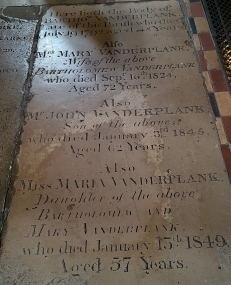A Dutch name on a gravestone in the City of London
AT THE OLD BAILEY court on the 18th of February 1767, Edward Wild was formally accused (indicted) of stealing 25 yards of woollen cloth worth £10 from the widow, Winifred Vanderplank (https://www.oldbaileyonline.org/record/17670218), and found guilty. At the trial, Winefred’s son Bartholomew Vanderplank told the court:
“I live in Bartholomew-close with my mother; I am a cloth-worker. Last Monday three weeks, the piece of cloth mentioned was taken away; the prisoner at the bar was stopped with it; I was before Justice Welch when he and the cloth was; he there confessed he took it away.”
According to “The records of St. Bartholomew’s priory and of the church and parish of St. Bartholomew the Great, West Smithfield” (publ. 1921), Mr Vanderplank lived close to the Church of St Bartholomew the Great, formerly part of the Priory that existed there until it was disbanded and partially demolished during the reign of King Henry VIII. The records stated:
“… The house of Mr. Vanderplank close by (he lived at No. 54 [ i.e., Bartholomew Close]) was the monastery kitchen from which a subterranean passage communicated with the church, persons having passed through it to the knowledge of the proprietor.”
The same records revealed that the Vanderplanks lived at 54 Bartholomew Close:
“In the London Directory of 1770, No. 54 was in the occupation of the Vanderplanks, cloth workers, who lived in the parish until the middle of the nineteenth century.”

You might be wondering why I should be telling you about a family whose surname indicates that it probably has Dutch origins. Well, the reason is that yesterday (the 2nd of April 2024), I was in the church of St Bartholomew the Great (near Smithfield Market) when I looked at the floor and spotted the gravestone recording the deaths of several members of the Vanderplank family, including that of Bartholomew, who appeared in court on the 18th of February 1767.
Regarding Bartholomew, he was affiliated to the City of London’s Clothworker Company (guild) (https://londonroll.org/search), as were some other members of the family, who lived in Bartholomew Close. I have not yet been able to find out when exactly the Vanderplank family settled in England, but I have read (www.ourmigrationstory.org.uk/oms/lond...
“The Flemish and Dutch arrived in England in large numbers in the fourteenth and fifteenth centuries and were primarily artisans, especially weavers and other cloth workers. This was partly due to ‘pull’ factors in the form of royal invitations and ‘letters of protection’ issued by the king. The Crown was keen to boost the English cloth industry by encouraging the arrival of skilled foreign workers. However, immigrants from the Low Countries also came due to ‘push’ factors, especially the hardships caused by warfare in the region and sentences of mass exile in the late fourteenth century for participating in revolts in Flanders.”
The top of the stone reads:
“Here lieth the Body of Barthow Vanderplank Late of the Parish who died July 19 1792 aged 48 years.”
The stone also commemorates the deaths of other members of his family – his wife and children. Because I was curious about the surname, I did a little research on the Internet, and found what I have just described.



